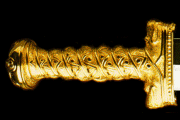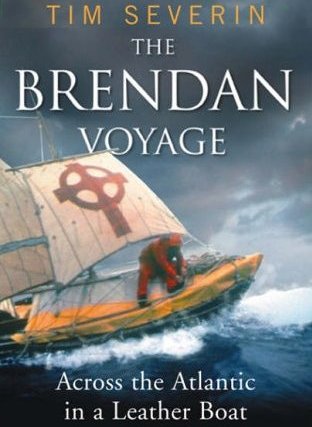Page 4 of 4
Avalon in the New World
Merlin and the Discovery of
Glastonbury Abbey in the county of Somerset, England. In medieval times this was said to be the site of Avalon where Merlin spent his last days. An earlier Dark Age account suggests that Avalon was much further away.
When England was invaded by the Anglo-Saxons in the sixth and seventh centuries many of the native Britons fled into Wales; others fled across the English Channel to France, and some crossed the Irish Sea to settle in Ireland, taking the stories of Arthur and Merlin with them. In these countries the Arthurian legend became popular, often being amalgamated with native legends. Lancelot, for example, was made into a French hero by Chrétien de Troyes. In Ireland, Merlin became a popular theme for romance, where his name was rendered as the Irish Maelduin, or Máel Dúin. Like Lancelot in France, the Irish portrayed Merlin as a native of their own country, in this case depicting him as a prince of Ninuss on the east coast of Ireland. Here, the legend of Merlin's voyage is described in detail in an eight-century saga called The Voyage of Maelduin's Boat. Although much of the Irish story of Merlin's voyage is embellished with fantasy, involving giants, demons and mythical creatures, Graham is convinced that many of the places described in the account could only have been made by someone who had actually sailed into the North Atlantic.
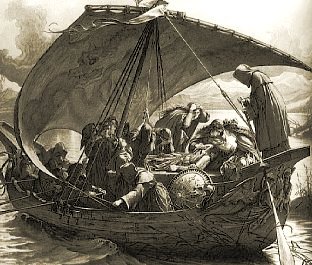
Merlin's Last Resting Place
Possible route described in The Voyage of Maelduin's Boat.
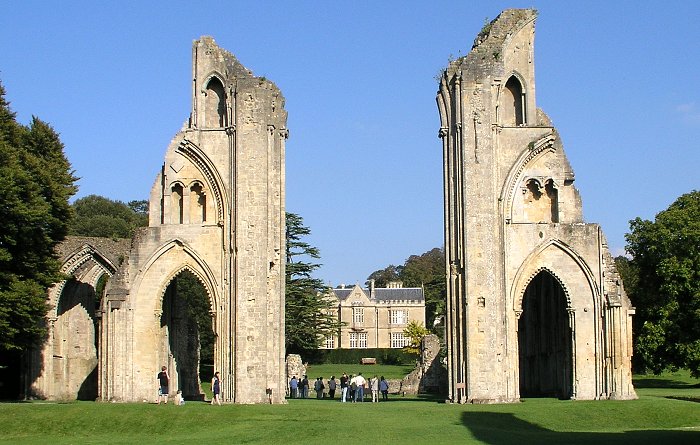
So what finally became of Merlin? Nothing is recorded concerning Ambrosius' demise, and in the Arthurian Romances there are many conflicting stories as to where Merlin ended his days. Some have him dying in Scotland and being buried at Drumelzier, while others locate his tomb outside the town of Marlborough in the English county of Wiltshire. One theme that keeps recurring, however, is that after leaving Arthur's court and spending time at the Grail Castle, Merlin sailed off to the mystical isle of Avalon. The problem is that different medieval authors give different locations for Avalon. For example, King Arthur is said to have been buried there, and various places are identified as his last resting place. These include Glastonbury in South West England (an island in ancient times, when sea levels were higher), Anglesey off the coast of Wales, and Lundy Island in the Bristol Channel. In King Arthur: The True Story, Graham identified another site for Arthur's possible burial, a lake island in Shropshire. However, the island that Merlin sailed off to does not seem to have been any of these. It is described as being across the Western Sea – in other words, the Atlantic. None of the British Arthurian Romances provide any details of Merlin's final trip to Avalon, but an imaginative account of it does survive from Ireland.
The Voyage of Merlin
The Voyage to Avalon by the nineteenth-century British artist Joseph Noel Paton. In the Arthurian Romances Merlin finally sails off the mystical
isle of Avalon.
In The Voyage of Maelduin's Boat, Merlin and a group of companions set sail from Ireland. The first land they sight is a group of islands, one of which is called "the island of sheep". Another is so full of birds that they cannot land. This might well be a description of the Faroe Isles. The Faroes consist of eighteen islands lying approximately 175 miles northwest of Scotland and some 400 miles due north of Ireland. Now belonging to Denmark, the islands were known to the Dark Age Vikings of Scandinavia who called them the Føroyar, from which the name Faroe comes. Føroyar means literally "Islands of Sheep" because of the hardy breed of large sheep that inhabit them. One of the Faroe Isles is the isle of Mykines, which still supports one of the densest colonies of seabirds in the North Atlantic. This would fit with the isle of birds described in the account.
After leaving these islands, Merlin and his crew sail on to a land where they are confronted by a terrifying wonder: a fiery mountain surrounded by smoke. If you sail 250 miles northwest of the Faroes you reach Iceland, a country renowned for its volcanoes – fiery mountains.
Merlin then sails on for many weeks across a bitter cold sea, where the only land sighted are strange floating islands. One is described in detail as:
A great column that was bright like silver… completely barren with no earth upon it… it towered above them and its base was far below; how far, they could not see.
This might easily be a description of an iceberg made by someone who had never seen one before. The Demark Strait, the 300 miles of sea separating Iceland from Greenland, is littered with icebergs, and the story describes what may indeed be a the coast of Greenland.
After that they voyaged till they entered a sea which resembled green glass. Such was its purity that the gravel and the sand of that sea were clearly visible through it; and they saw no monsters nor beasts therein among the crags, but only the pure gravel and the green sand.
Greenland is named after its exotic green seas, caused by an unusual green sand on the east coast of the country (a variety of sandstone consisting of glauconite, potash, and phosphate of lime).

The Faroe Isles, perhaps the first islands described in The Voyage of Maelduin's Boat.
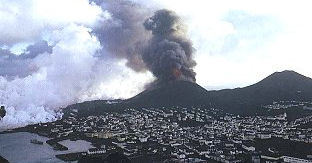
The eruption of Iceland's Eldfell in 1973.

Were Merlin's floating islands really icebergs?

Greenland's unique and exotic greens seas.
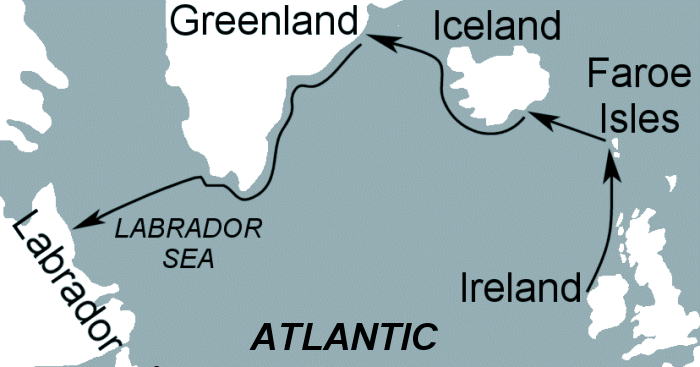
That an eight-century tale appears to describe the Arctic is fascinating enough, but The Voyage of Maelduin's Boat even seems to describe the coast of northern Canada. The crew eventually reach a forested country with beaches consisting of mile upon mile of pure white sand. As unlikely as such a place might sound, there is a stretch of the Canadian coastline that matches this description exactly. A magnificent white sandy beach known as the Porcupine Strand stretches for over twenty miles along the coast of Labrador on mainland Canada, directly across the Labrador Sea from Greenland. (The unusual color of the sand is derived from quartz deposits left by retreating glaciers at the end of the last Ice Age.) This unique coastline, set against a backdrop of the forested Mealy Mountains, may well be the place described in the tale.
Was it Possible?
It might seem impossible that anyone from the Dark Age British Isles could have made such a sea voyage to North America half a millennium before the Vikings are known to have done so, but in the mid 1970s the British historian Tim Severin proved it was possible.
Another Dark Age account of an Atlantic voyage concerned a sixth-century Irish monk named Brendan. This account also provided descriptions of stretches of coastline that matched Iceland, Greenland and Northern Canada. Convinced that such a voyage was possible, Severin built a replica of an Irish boat of the period and successfully made the crossing from Ireland, via the Faroes, Iceland and Greenland, to Canada. Remarkably, what had been imagined to be the most perilous part of the crossing, from Iceland to Newfoundland was achieved in less than two months. It took courage, but Severin proved that crossing the Atlantic in a sixth-century Irish boat, by island hopping through the Arctic in summertime, was far easier and quicker than anyone had imagined.
Tim Severin may not have known it, but he had not only proved that Brendan's voyage was possible, but that Merlin's voyage had been possible too.
Avalon in the New World
The mysterious island of Avalon may have been different places to different writers, but the Avalon that Merlin is said to have sailed to might well have been an island off the coast of North America. If The Voyage of Maelduin's Boat was based on a real Atlantic sea crossing, then some of the crew obviously returned to tell the tale. If the medieval Arthurian Romances are to be believed, however, Merlin remained behind on Avalon. So which island on the American coast might Merlin's Avalon have been?
In The Voyage of Maelduin's Boat, after reaching the coast of what might be Labrador, the crew sail on to much warmer and hospitable lands. By the type of vegetation described, they might have traveled as far south as what is now the coast of New England in the United States. In the Arthurian legend, Avalon is sometimes described as Manannan Island, named after the Celtic sea god Manannan who is said to have lived there. An island off the coast of Maine bears the very similar name Manana Island. This was the original Native American name for the island, meaning "island in the sea". Interestingly, there are a number of standing stones on the island, speculated to have been erected by early Irish voyagers; one rock even bears a mysterious inscription which it has been suggested might be Celtic in origin.
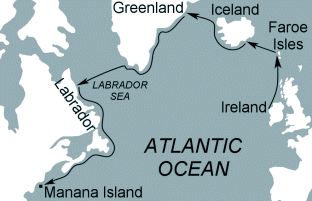
The sea god Mannanan is said to have ruled the isle of Avalon. Could the real island of Mannanan have been Manana Island off the cost of Maine?








